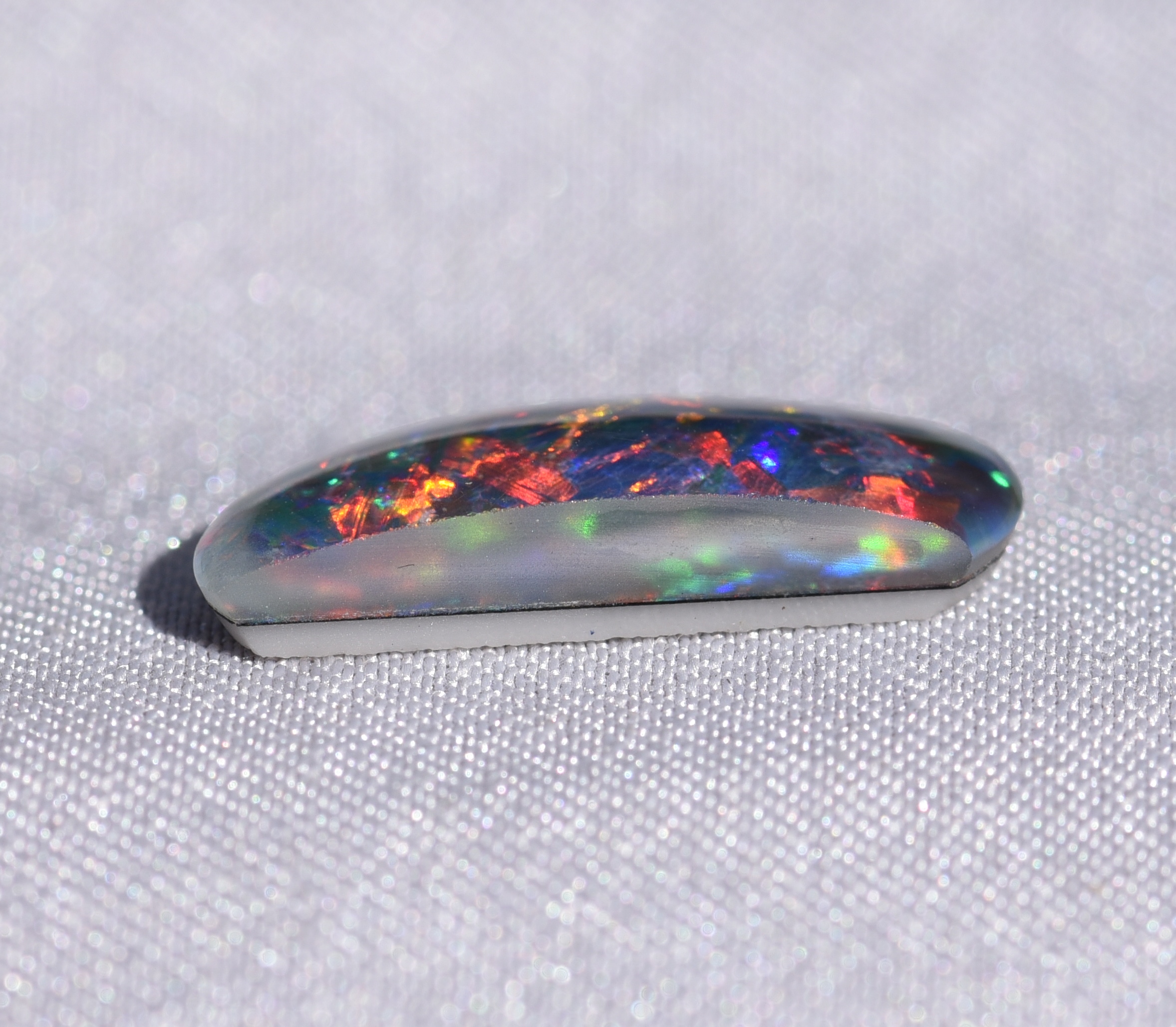Two interesting specimens of boulder matrix opal
Recently two different specimens of boulder ironstone matrix opal have come across the research table of the opal academy. The field of origin knowledge of the two specimens are unknown at this time. One is from our colleague Peter Sherman from a part of Peters family collection. The second one is from a colleague in Western Australia from an enquiry he recieved . The stone did not originate in Western Australia.
hydrophane type ironstone boulder matrix opal.
A broken oval cabachon of hydrophane type boulder ironstone matrix opal. The top section of the cabochon has been immersed in water and the bottom section of the stone shows the normal state.
A photomicrograph of a portion of the ironstone boulder matrix hydrophane opal partially showing the difference between where the opal absorbed water (darker portion at top), and the dry white portion below.
After more complete immersion
The ironstone matrix of this opal is typical of boulder ironstone matrix opal for Queensland even though the exact field deatils are unknown. Previously we had heard of a hydrophane type boulder matrix in discussion at an opal symposium in Winton, Queensland. At the time and after a request we recieved some similar material for examination from Cody Opals in Melbourne. At the time of testing it was difficult to determine the true nature of the Cody samples. This sample in the pictures above however was significantly more absorbent and worthy of sharing with the gemmological community.
A specimen of boulder opal where the opal is separating form teh ironstone
The same specinmen which has been “whetted” after imersion in water.
The two pictures to the right show a subtle defect that may occur in a very small amount of boulder opal where the opal layer that is attched to the ironstone may partially separate. The photo on the left is a photo that shows the opal separating. The photo on the right is a photo of the same opal that has been immeresed in water, note that the water has “whetted” the contact betweeen the opal and the ironstone. This is not an indication of the opal being hydrophane.
Magnetically attracted boulder ironstone matrix opal
A free from cut flat cabachon of the magnetically attracted ironstone boulder matrix opal seen recently
A micrograph of the stone pictured left at a magnification of approximatley 20x
A larger magnification (approx 45x of the magnetic ironstone matrix opal
The reverse (back side of the stone.
This speciment of boulder matrix opal is different to most of the other boulder ironstone matrix opal seen. It is strongly attracted to a magnet. See video above.
When first examined this opal presented some mineralogical enigmas. Whilst there is no doubt that there are many different forms of boulder ironstone matrix seen throughout the boulder opalfields in Queensland, and a substantial number of differing forms, patterns and concretions in particular from the Yowah opalfields which provide many differing specimens, this is the first magnetically attracted opal we have seen.
The speciment is also very “black” when compared with many specimens. Even the darkest specimens of boulder matrix seen, have some very dark brown tint. In some Yowah nuts, there are bands of Haematite which when polished gives a typical silvery metallic lustre to the stone. A comparison with this material showed that the heamatite was, as expected not magnetic. Similar comparison was made with a specimen of yellowish brown so called “bubble” ironstone matrix from Koroit in Queensland, and again this material was not magnetic.
As gemmologists are naturally wary about specimens it was considered that the specimen above may have been treated to make it as black as it appeared to be. As mentioned it was expected to have the typical brownish tinge. No treatment could be observed, however further testing will be required to confirm no treatment.
Also examined was the density or specific gravity of this particular specimen as it felt light in heft. The result was surprising with a density (SG) of 2.43.
By comparison the density of the Koroit matrix was 2.87, and the small Yowah nut with the polished heamatite band was 3.16.
After discussion with one of our mineralogists, Bruce Dickson, we considered what options may be avaialle to use which were non destructive, and considered also what available mineral species may offer some insight. A list of iron oxide minerals were discussed, from Ferrihydrite, Maghemite, Haematite, and Magnetite. The suggestion was that the mineralogical test of examining the “streak” of the samples may give a clue..
Photograph of the streak test.
We performed a streak test on the spcecimen an compared that to known data as well as the afformentioned speciemens.
Ferryhidrite has a yellowish brown streak.
Maghemite has a black to dark grey streak
Heamatite has a rust or brown red streak and magnetite has a dark gray streak.
From left to right the Koriot bubble opal (yellowish brown), The Yowah ‘haematite’ specimen (reddish brown), a very dark “chocolate” brown specimen, also yellowish brown, and the magnetic specimen on the right, dark grey.
This testing is not conclusive, and it is not suggested that the yellowish brown streak is necessarily indicative of ferryhidrite in this instance, it does however suggest that the dark grey streak may be indicative of the presence of magnetite.
conclusion
The three specimens used in this discussion are shown below. Some mysteries remain about the specimen that is magnetic. We postulate that there is sufficient amounts of magnetite in this particular specimen to make it magnetic even though the density is very low. What the mechanism of formation for this material is also remains a mystery. Comments, ideas and discussion are welcome.
Koroit “bubble’ ironstone matrix opal
Small Yowah nut polished haematite like specimen
Dense dark chocolate brown ironstone matix opal





























